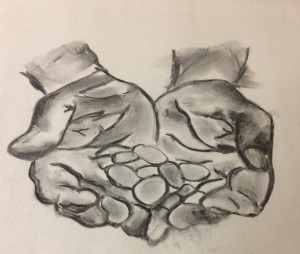Who is the Beggar?
While reading the Beggar’s Strike, I was inspired by the relationship between the beggars and the upper castes. Traditionally I think of beggars as people who rely on others with more means to provide them with money and stability. In this story, however, the beggar’s utilized the Muslim need to give alms as a way to wield power over wealthier people. Throughout the story, I attempted to choose the party with the most power. Do the people with more money always have more power? In our society, yes, traditionally that is true. But in the Muslim community reflected in this story, the beggars wielded as much, if not more power over Mour in his quest to become vice president. Because of this complicated power dynamic, I thought of the act of giving and receiving money or a donation. One’s hands are typically folded within one another and cupped when receiving a donation. But similarly, when one is giving a donation, one also uses outstretched hands. Because of this duality, I felt that the hands of a beggar were an accurate representation of the power question that I felt central to the story. In addition, when Muslims pray, they hold their hands in the same position. This led me to ponder the relationship between praying, begging, and receiving. Praying is essential in Islam regardless of one’s socioeconomic status; this is important because it connects to the uncertainty of the power structure. Religion is never on the side of the rich or the poor. Even though in The Answer God describes the poor people as better Muslims, overall, in the eyes of God, all Muslims are equal.
